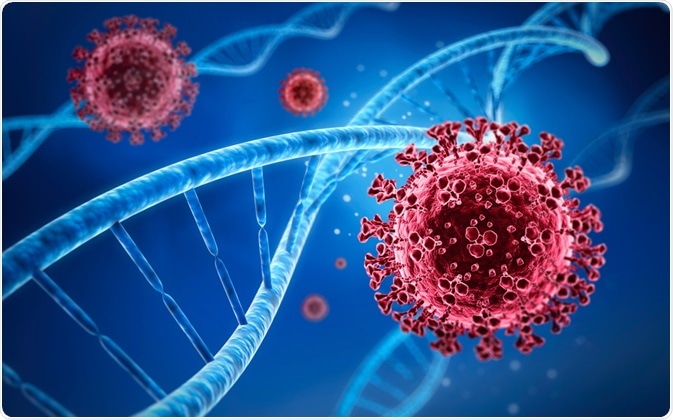Virology is a study of viruses, which are small parasites that are not able to reproduce by themselves. However, upon infection of a susceptible cell, viruses can direct their cell machinery to produce progeny. Viruses can be classified by a number of different methods including the disease they trigger, morphology, host range, and nature of the genome in association with the method of replication and transcription.

Image Credit: petershreiber.media / Shutterstock.com
Virus genomes consist of either DNA or RNA and may be single-stranded or double-stranded. Some viruses convert their genomes from RNA to DNA (or vice versa) for replication and transcription purposes. The Baltimore system is often employed due to its potential to predict general features of the replication and transcription of viruses just from knowing the nature of the genome.
Molecular biology of viruses
The viral genome contains all the information needed to initiate and complete an infectious cycle within a susceptible, permissive host cell. An infectious cycle includes attachment and entry, production of viral mRNA and proteins, genome replication, and, finally, assembly and release of new particles.
The genomes of viruses encode from as few as one protein to more than a hundred. Those that are present in virions, which are mature viral particles, are also known as structural proteins. Comparatively, the viral genomes that are involved in the assembly, replication, and modification of the host's innate response to infection are referred to as non-structural proteins.
Practically all DNA viruses which infect humans and animals contain double-stranded DNA. Exceptions include the Parvoviridae (e.g., parvovirus B19, adeno-associated virus) and the Circoviridae, which includes the transfusion-transmitted (TT) virus that is possibly related to the development of some cases of hepatitis.
Almost all RNA viruses contain single-stranded RNA. Exceptions include the Reoviridae (e.g., rotaviruses) which contain double-stranded RNA. Other RNA viruses can be broadly subdivided to two groups, which include viruses with positive-strand RNA genomes (i.e. genomes of the same polarity as mRNA) and viruses with negative-strand RNA genomes (i.e. genomes of the opposite polarity to mRNA).
Molecular analysis of viral genomes can be separated into two types of approaches, the first of which is a physical analysis of structure and nucleotide sequence performed in vitro. The second approach is a more biological method that examines the structure-function relationships of intact virus genomes and individual genetic elements, generally involving analysis of the virus phenotype in vivo.
The use of viruses in the treatment
The principal aim of gene therapy is to correct a genetic defect via the transfer of a functional normal copy of the gene into cells. Viral gene delivery systems consist of viruses that are modified to be replication-deficient and can deliver the genes to the cells to provide expression. This can be used in genetic disorders, autoimmune diseases, and viral infections.
Adenoviruses, retroviruses, lentiviruses, adeno-associated virus, and herpes simplex virus are most often used for viral gene delivery. Viruses naturally exhibit cell tropism, thus altering the surface receptors of the virus, or using cell-type-specific promoters to control the expression of inserted genes, which can be used to improve specificity.
Although non-viral vector systems, such as hydrodynamic delivery, lipid-mediated vectors, and the gene gun have been tried, none have, to date, approached the efficacy of the viral delivery systems. However, there are some limitations that restrict the use of viruses as vectors, particularly the use of viruses in production, toxicity, immunogenicity, and inadequate optimization in large-scale production.
Oncolytic viruses are the type of viruses that preferentially replicate and kill tumor cells while sparing healthy tissues, which is a property that can be inherent or genetically modified. Inherent tumor-specific viruses can precisely target cancerous tissues by exploiting characteristic cellular defects and aberrations.
Currently, there are many clinical trials in progress including the use of oncolytic viruses in head and neck squamous cell carcinoma, colorectal cancer, thyroid cancer, liver cancer, glioblastoma multiforme, and melanoma treatment. The administration of these therapeutic oncolytic viruses is generally well tolerated, albeit further clinical studies evaluating their efficacy and safety are warranted.
Bacteriophages (or simply known as phages) are viruses that have the ability to infect and, in many cases, kill bacterial cells. The use of bacteriophages as a therapeutic tool in modern medicine has essentially resurfaced after the widespread use of phage therapy in the pre-antibiotic era lost favor when antimicrobial drugs were introduced.
Today, bacteriophages represent a possible alternative tool for the treatment of bacterial infections, including those caused by multidrug-resistant pathogens. Nevertheless, since large, randomized controlled trials (RCTs) are currently lacking, it is difficult to evaluate their side effects and potential impact.
References
Further Reading
Last Updated: Jun 19, 2023